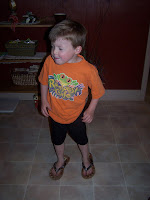Possible Symptoms of Syringomyelia: Back pain; headaches; stiffness, weakness or pain in the back, shoulders, arms or legs; loss of the ability to feel extremes of hot or cold, especially in the hands?
What is syringomyelia? (sear-IN-go-my-ELL-ya)Syringomyelia (SM) is a disorder in which a cyst forms within the spinal cord. This cyst, called a syrinx, expands and elongates over time, destroying the center of the cord. Since the spinal cord connects the brain to the nerves in the extremities, this damage may result in pain, weakness, and stiffness in the back, shoulders, arms or legs. Other symptoms may include headaches and loss of the ability to feel extremes of hot or cold, especially in the hands and disruption in body temperature. SM may also adversely affect sweating, and bladder and bowel control.
 My sister Linda has it,
My sister Linda has it, and she is suffering. I am asking for your prayers for Linda. She is an amazing woman and sister to me. She is the firstborn of 9 and, if you have been following my blog at all, you know growing up was not so easy at our house. 11 people in a 2 bedroom house with no furnace and no running water and no bathroom....and no money. Linda actually went to work in town and bought things for her brothers and sisters, helped Mom with expenses, cooked, cleaned, fed and bathed the little ones. I really remember Mom saying that Linda was like a "little mother". She made sure everyone else was taken care of and fed before she ate. She is still like that today. Caring for everyone else before herself....but right now she is in pain and heartache, not knowing what the next step will be for her. It is hard to see her in pain and so upset.
 What causes Syringomyelia?
What causes Syringomyelia?
Trauma to the spinal cord or congenital developmental problems of the brain and/or spinal cord may result in SM.
Spinal cord trauma such as a car accident or serious fall may manifest years later as SM.
Congenital developmental problems, sometimes undetectable may result in syringomyelia. In either case, the condition may lie dormant and undetected for months or years until a symptom or variety of symptoms become bothersome enough to warrant medical attention. Many people with SM are not diagnosed until mid-life. A number of medical conditions can cause an obstruction in the normal flow of cerebrospinal fluid (CSF), redirecting it to the spinal cord itself. This results in the formation of a syrinx (cyst that fills with CSF). Pressure differences along the spine cause the fluid to move within the cyst. It is believed that this continual movement of fluid results in cyst growth and further damage to the spinal cord and connecting nerves.
Linda has had 2 spinal surgeries, the first to place a shunt in the cyst, and then a repeat surgery as the shunt plugged up and the cyst reoccured. She has a huge scar at the base of the neck, pain and stiffness and now the numbness has returned. An MRI shows the cyst is substantial.
Her options, as she told me and hopefully I have it correctly: 1. leave it, watch it continue to grow and impair her, causing pain and loss of strength and loss of feeling, possibly leading to paralysis.
2. have an additional surgery, to try to repair it, and face paralysis now with the invasion into the spine. The doctor told her that if her first surgery was tough and her second surgery was really, really tough, this surgery would be worse than the 2 put together.
She could really use your prayers. I love her so, so much and hate to see her in pain, as well as the pain of the decision she must face.
Linda, I love you forever and will help you any way I can. Let me know what I can do for you. You have always been there for me!




.JPG)
.JPG)
.JPG)









.jpg)




a.jpg)































